🟧 [ Dutch week ] Urbanism and biking
![🟧 [ Dutch week ] Urbanism and biking](https://images.unsplash.com/photo-1557436552-d1d884f1bb62?crop=entropy&cs=tinysrgb&fit=max&fm=jpg&ixid=MnwxMTc3M3wwfDF8c2VhcmNofDR8fGR1dGNofGVufDB8fHx8MTY2MTY2ODA0OQ&ixlib=rb-1.2.1&q=80&w=1200)
I've briefly discussed some elements of Dutch design and the 'doe normaal' mindset in a previous article. I also wanted to pin down a few videos for future reference on this topic since, as a foreigner calling the Netherlands my home, I happen to discuss them quite a lot.
The first video is about population density, the biking infrastructure, and the water engineering prowesses of the Dutch:
Key points:
- The density population of the Netherlands is above that of most other European countries. Handling population movement around the country and spreading habitation density has been a top priority for decades. In that regard, the bike is not about a laid-back way of life but an extraordinarily efficient asset for smooth urban planning.
- Ensuring mobility continuity is paramount. In that regard, the 32,000 km of cycling tracks can only work if cars are integrated around them (not the other way around) and if public transports are always ready to prolong your bike journey.
- Even Rotterdam, bombed during WWII and initially rebuilt around cars and motorways, managed to shift away from the car-centric model in the eighties. As such, this is an optimistic template for any other 'regular' European city.
- If mobility and urbanism are well planned, they can only do so much if, no matter what, you lack landmass. And as you probably know, the Dutch have built quite a well-deserved reputation for engineering their coastline, swamps, and lakes. More than 20% of the Netherlands has been regained with dams, sluices, locks, dykes, levees, and storm surge barriers. The iconic windmills were not used to produce electricity or ground wheat in flour but to pump water out of the fields.
- These water engineering skills are also why the port of Rotterdam is so big (one and half the size of Manhattan) and so well connected to different waterways, canals, and deep water basins.
The second video focuses on what good zoning is and why it makes a city formidably human-centered:
Key points:
- Most North American cities follow Euclidian zoning (streets and avenues crossing at square angles, delimiting different land use types in different zones). If you follow this zoning rule too strictly, you end up keeping residential zones away from commercial and industrial zones. This creates a massive disconnect between 'where people sleep' and 'where they do things, which you can only resolve by using cars.
- In the Netherlands, residential zones are dotted with various activities, from shops to restaurants and schools, which makes a walkable city that doesn't require using a car most of the week.
- (This concept taken too literally or pushed too far, created the paradigm of the 15-Minute City where you should be able to access anything within fifteen minutes from where you live. Nice idea, but it doesn't work – this should be a discussion for another time).
Lastly, here's another video from Not Just Bike, giving you a ground-level view of what it's like to bike in the city where cars are not the apex predator of the streets (enjoy):


